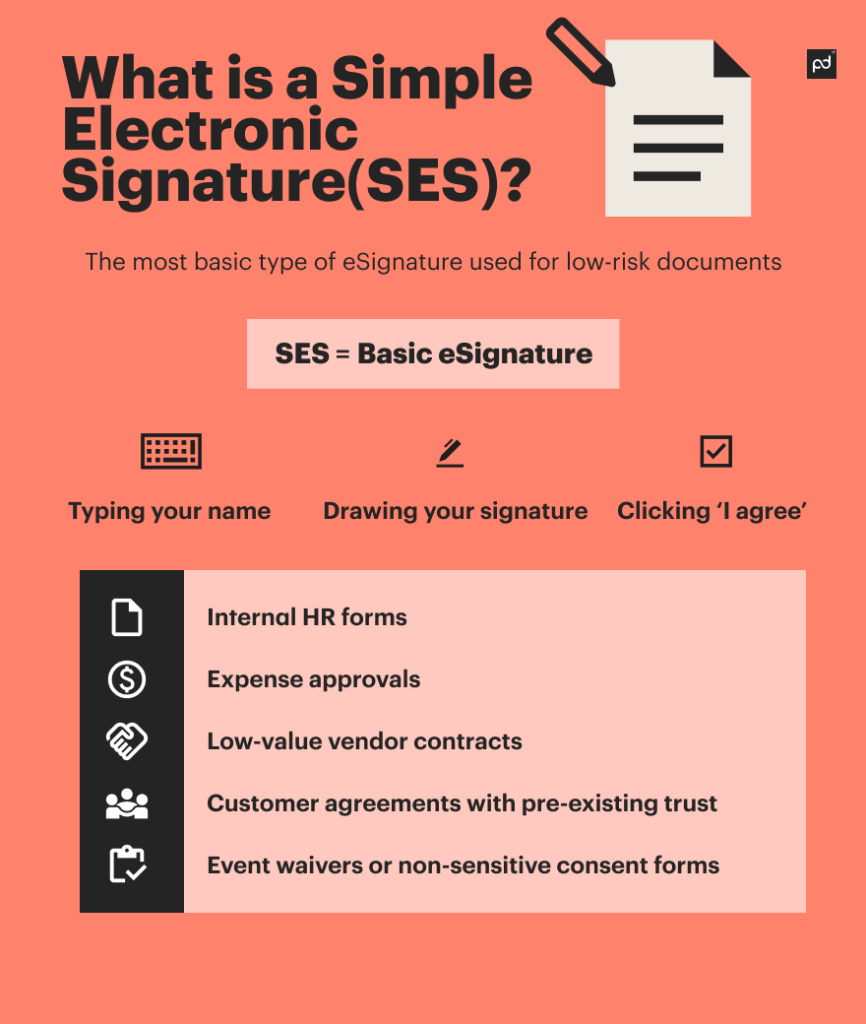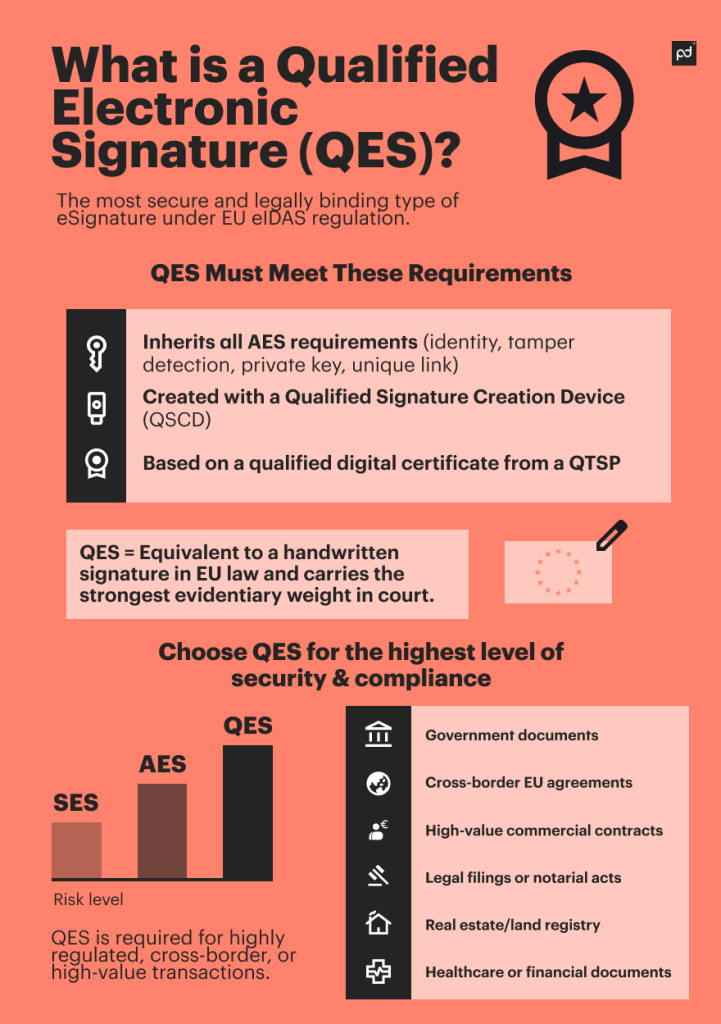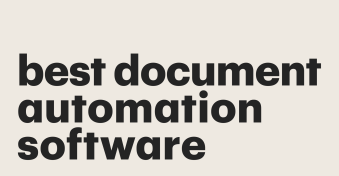The days of signing documents with a pen, paper, and a physical presence are in the past.
What’s changed? Electronic signatures.
Electronic signatures, or eSignatures, make document management much faster, more secure, and even more convenient than it’s ever been. There are multiple types of eSignatures, and understanding their differences will help you choose the right one for you, whether it’s for personal or professional use.
When you’re signing anything from a sales contract, onboarding a new hire, or approving internal documents, it’s important to understand the type of eSignature you’re using and its security levels. Choosing the wrong type could mean exposing your company to unnecessary risk or compliance issues. This can be especially relevant if you work in a regulated industry or you regularly do business internationally.
In this article, we’ll cover everything you need to know about different types of electronic signatures, including simple, advanced, and qualified ones. We’ll also talk about how they work and help you decide which one will work best for you.
What is an electronic signature?
An electronic signature acts just like a physical handwritten signature, sometimes called a wet signature, when indicating agreement on a digital document. It can be as simple as typing your name, drawing a signature with your finger or mouse, or clicking a button that states “I accept.”
There are also more complex ways to digitally sign that involve identity verification and encryption.
The point of an electronic signature is to show intent and consent on an agreement. It indicates that the signer agrees to all the contents detailed in the document and understands it is legally binding.
Many parts of the world recognize and honor electronic signatures, including the U.S., EU, UK, Canada, Australia, and more.
There are certain rules that define how valid and secure an eSignature must be to be considered legally binding, depending on jurisdiction and regional laws such as the E-sign Act.
The 3 types of electronic signatures
Under the EU’s eIDAS regulation, there are three main types of electronic signatures that are recognized:
- Simple electronic signatures (SES)
- Advanced electronic signatures (AES)
- Qualified electronic signatures (QES)
As you can guess, these signature types vary in complexity and security. SES is the most flexible but least secure, while QES offers the most identity assurance and legal protection of the three.
With each having different levels of identity assurance, security, and legal enforceability, you need to know the key differences between these electronic signature types so you can decide what will work best for your situation.
Simple electronic signatures (SES)
A simple electronic signature is the most basic kind of eSignature. The eIDAS regulation defines an electronic signature as “data in electronic form which is attached to or logically associated with other data in electronic form and which is used by the signatory to sign.”
Here are a few examples of what this could look like:
- Typing your name into a contract
- Drawing your signature with a stylus or mouse
- Clicking a checkbox that says “I agree”
Because SES doesn’t need any formal identity verification or advanced tech, it’s easy to use and widely applicable to a variety of circumstances. But that comes with less legal assurance, as it’s pretty easy to forge or dispute.
Even though SES can be sufficient for some routine agreements, it’s not always the best for providing auditability or legal strength when it comes to more sensitive transactions.
When to use an SES
Simple electronic signatures are a great option when dealing with low-risk or internal transactions where identity verification isn’t as essential.
This could be:
- Internal HR forms
- Expense approvals
- Low-value vendor contracts
- Customer agreements with pre-existing trust
- Event waivers or non-sensitive consent forms
SES is also great for small businesses and startups that need to focus on speed and ease of use. But always keep in mind whether you need a more secure option, depending on the type of agreements you’ll be working with.

Advanced electronic signatures (AES)
An advanced electronic signature (AES) has a higher level of security than SES, and needs to meet some specific requirements:
- It must be uniquely linked to the signer
- It must allow identification of the signer
- It must be created using data the signer can use with a high level of control (such as a private key)
- It must detect any changes made to the signed data after the signature
Advanced electronic signatures (AES) have an “electronic seal” attached to them. They are transmitted through an electronic registered delivery service (ERDS) for additional verification.
Often, a Certificate Authority (CA) issues certificates that authenticate advanced electronic signatures to make sure the document hasn’t been tampered with.
AES utilizes a Public Key Infrastructure (PKI) technology, also known as asymmetric cryptography, to satisfy these requirements. The PKI process is how a digital certificate verifies digital signatures.
Keep in mind that this is different from a symmetric key algorithm that relies on a single key to encrypt and decrypt data.
In a way, a digital certificate resembles a passport or driver’s license, in that a third-party CA has verified it. Each digital certificate is unique to the individual and is nearly impossible to be convincingly replicated.
The signatory remains the sole holder of the private key, which is required to apply the signature. The parties can feel confident that the other signer or signers are the people they say they are.
As part of the signature verification process, the PKI software automatically reviews documents to ensure that no one has made changes to them. If someone edits a document, all parties are notified, and the process begins again.
The legal community usually considers AES as valid as traditional wet-ink signatures. Attorneys routinely cite the verification process as a reason to use AES as reliable evidence in court proceedings.
How do advanced electronic signatures differ from basic ones?
AES and SES are both legally valid, but AES is more trustworthy and secure with the advanced technology listed above.
You’re not simply typing a name or drawing a squiggle with an AES; instead, it’s tied to the signer through a verifiable digital certificate, making it much harder to impersonate a signer or change a document after signing.
When to use AES
You want to opt for advanced electronic signatures when the stakes are higher and you need strong identity assurance, tamper-proof documents, or legal compliance for mid-risk business transitions.
Some common use cases are:
- Loan agreements
- B2B contracts
- Intellectual property documents
- NDAs with sensitive data
- Procurement and vendor onboarding
- Cross-border commercial transactions

Qualified electronic signatures (QES)
The most secure and legally binding type of electronic signature under the eIDAS regulation is a qualified electronic signature (QES). It meets all the requirements of an AES, plus:
- It must be created using a qualified signature creation device (QSCD)
- It must be based on a qualified digital certificate issued by a Qualified Trust Service Provider (QTSP)
QES are validated through a multi-step process based on encrypted keys and double-factor authentication. Essentially, an agreed-upon third party vets the signers before they can issue a qualified electronic signature.
It’s important to state that having a higher security standard doesn’t necessarily mean it is better. We’re simply saying it conforms to a higher set of security requirements compared to its AES counterpart.
QES is equivalent to handwriting a signature in EU law and tends to hold the greatest evidentiary weight in legal proceedings.
With their robust safeguards, QES are often used in highly regulated industries and for official governmental or international transactions.
So what’s the difference between AES and QES?
AES and QES signatures both provide the highest industry-accepted standards of trust and assurance.
Each of them assigns a unique key to every user, which is directly linked to the signer’s identity.
This means that a court of law would determine exactly who signed the document. There’s no question about that.
Think of it this way. To qualify for the NBA league, you need to be pretty tall. The average player is somewhere in the realm of 6 ft. 7 in. Now, if you were 6 ft. 8 in. tall, would you qualify? What if you were 7 ft.?
Would that earn you a spot in the league? The answer to both these questions is – yes.
In the same way, AES and QES signatures both provide the highest industry-accepted standards of trust and assurance.
Each of them assigns a unique key to every user, which is directly linked to the signer’s identity. This means that a court of law would determine exactly who signed the document. There’s no question about that.
The main difference is that a QES requires you to jump through more hoops, one of which involves you undergoing a formal registration process for a qualified Certificate Authority to verify your identity.
When to use QES
Qualified electronic signatures are typically required when signing:
- Government documents
- Cross-border agreements in the EU
- High-value commercial contracts
- Legal filings or notarial acts
- Real estate or land registry transactions
- Regulated healthcare or financial documents
QES often involves more steps for the signer, like identity verification through government-issued ID or video authentication. This extra effort can be worth it for the additional security if you’re dealing with high-stakes agreements.
QES requirements
The eIDAS definition for a QES is “an advanced electronic signature that is created by a qualified signature creation device and which is based on a qualified certificate for electronic signatures.”
Right away, we can guess that a “qualified signature creation device” will need to meet specific guidelines. Sure enough, there are several requirements these devices must satisfy.
The device must:
Protect the confidentiality of the electronic signature creation data
Allow for only one usage of the QES
Guard against forgery
Be reliably protected by the legitimate signatory
Not alter the data or prevent it from being presented to the signatory before signing
Generate or manage signatory data on behalf of the signatory only at the behest of a qualified trust provider
If this explanation seems confusing, just remember that if you want to use QES, each step must meet the qualifications set out in eIDAS.
This also means that you need to be discerning when looking for an electronic signature service provider. If a provider does not mention eIDAS and other regulations related to e-signatures, consider it a red flag.
To qualify for QES status, the eIDAS regulation requires all parties to use data on a device that is backed by a “qualified certificate for electronic signatures.”
Only a CA accredited as a Qualified Trust Service Provider (QTSP) can issue qualified certificates. If your e-signature service provider is not a CA, be sure they partner with a reliable CA.
All in all, whether you choose an AES or a QES, the most important thing to know is that they are both legally enforceable in a court of law.
Getting an AES, however, is much less of a hassle since it doesn’t require you to overcome a whole bunch of hurdles just to make your business-critical documents legally binding.
When you need a qualified electronic signature (QES), for example, on government forms, international contracts, or high-value commercial agreements, the easiest way to get one is through an eSignature platform. PandaDoc supports QES by integrating with trusted identity providers (IdPs), which handle the strict identity verification required by law. PandaDoc also makes it easy to manage QES workflows by supporting multiple signers and tracking each step of the process. This ensures that your document meets the highest legal standard for electronic signatures in the EU and other regulated regions.

Which eSignature should I use to stay compliant?
So, you’re ready to move forward with finalizing an agreement. Which e-signature type is right for you?
This will mostly depend on how important it is to you that the agreement in question would hold up in court (in which case, a simple electronic signature is out of the question), and how many hoops you’re prepared to jump through just to get it.
If you want more assurance that it would be legally binding in the eyes of a judge, have your agreement signed with an AES or QES.
Both of these establish higher levels of trust and assurance and are much more likely to convince legal authorities of a contract’s legitimacy.
An AES, however, presents a more convenient alternative that doesn’t require you to present yourself to a Certificate Authority and undergo a rigorous vetting process before they can issue you with QES.
International considerations
While the eIDAS regulation was created by the EU, businesses and individuals conducting business with EU countries will likely need to comply to be considered a party to a legitimate legal agreement.
There are also two United States regulations that you’ll need to consider:
The uniform electronic transactions act (UETA)
Established in 1999, the UETA regulation is managed by state legislators. This means that these electronic signature laws only apply in US states that have adopted them.
Currently, UETA regulations have a legal effect in every state except Illinois, New York, and Washington.
Because of how the US government is structured and the guidelines laid out in the US Constitution, individual states control trade matters instead of the federal government.
The Constitution does require that states adopt a uniform response when it comes to interstate commerce.
If you live in California and need an agreement signed by someone in New Jersey, you’re conducting interstate commerce. The federally mandated E-Sign Act covers this type of arrangement.
The legality of electronic signatures as stipulated by UETA
For an eSignature to be considered valid and enforceable, it needs to meet the following requirements:
- Consent: All parties to the agreement have to be privy to the electronic signing process.
- Intent: The signer needs to show intent by actively attaching a digital signature for electronic document signing.
- Association: The electronic signature solution selected must be linked to the digital document at the time it is signed and saved in Adobe PDF or any other chosen file format.
- Attribution: The eSignature needs to be attributable to the signatory subject to the context and circumstances surrounding the signing process. This could be in the form of an IP address, date/time stamp, or any other relevant metadata.
- Record retention: The electronic document should be saved in a form that can be retrieved and reproduced when need be. It also needs to maintain an accurate audit trail of all actions taken at every stage of the workflow.
Electronic signatures in global and national commerce act (e-sign act)
Established in 2000 by President Bill Clinton, the E-Sign Act explicitly legalizes e-signatures.
The legal text states that “contracts established on the internet will now have the same legal force as the equivalent contracts on paper.”
Like the eIDAS, the E-Sign Act lays out guidelines for establishing authority and authenticity of e-signatures, as well as rules for how to obtain, protect, and retain documents that include e-signatures.
If your organization frequently sends and receives signed documents, a document management solution, like PandaDoc, can help you stay compliant with all the laws and regulations related to signing digital documents.
Most modern platforms, ensure immediate compliance with the eIDAS regulatory guidelines that call for locally-held electronic identification credentials, the control and confidentiality of said credentials, and the identity of the signer, and direct linkage to the signatory.
SES vs AES vs QES

How electronic signatures work in PandaDoc
In PandaDoc, our users have access to all three levels of electronic signatures recognized under the EU’s eIDAS regulations.
PandaDoc offers built-in features like custom workflows, signer authentication, and secure storage, making it easy to adapt to any compliance or risk level. That means you get the right flexibility and security whether you’re onboarding a new client or submitting a legally binding government document.
- Simple electronic signatures (SES): For everyday agreements like proposals, NDAs, or client intake forms, PandaDoc makes it fast and frictionless. You just drag and drop a signature field, and your recipient can sign with a click—no downloads or special setup needed.
- Qualified electronic signatures (QES): For highly regulated use cases (think government filings or contracts under eIDAS in the EU), PandaDoc integrates with qualified trust service providers (QTSPs) to issue QES-compliant signatures. This ensures signatures meet the highest legal standard in many jurisdictions.
- Advanced electronic signatures (AES): When you need more security—like two-factor authentication or proof of identity—PandaDoc supports advanced signer authentication methods such as email/SMS verification, password protection, and certificate-based signing.
The bottom line
Having a better understanding of different electronic signature types will help you keep your docs secure and legally compliant while ensuring they are appropriate for the level of risk involved.
PandaDoc gives you the flexibility to choose from simple, advanced, or qualified eSignatures. And the best part? It comes with a user-friendly platform.
Just ask our client, Pierre Roy & Associés, who switched to PandaDoc for a secure eSignature solution that integrates directly with their CRM via API.
“The security of our client data is a regulatory requirement, and the peace of mind that comes with knowing our clients’ sensitive information is securely handled is huge. PandaDoc’s SMS verification provides the extra layer of security we need to ensure that our documents reach the right hands. It’s a crucial aspect of our compliance strategy, offering a level of trust and reliability that our clients expect and deserve.”
– Jonathan Roy, Administrative Director at Pierre Roy & Associés
Ready to see how PandaDoc eSignatures can work for you? Get a 14-day trial.
Frequently asked questions
-
The three main types of digital (electronic) signatures are:
- Simple electronic signature (SES): This is a basic eSignature that’s flexible, which can include typed names or checkboxes.
- Advanced electronic signature (AES): This type includes encryption and identity verification.
- Qualified electronic signature (QES): This type of eSignature offers the highest security and legal standing, and it uses certified devices and trusted providers.
-
Docusign supports both AES and QES, but it depends on the plan and compliance requirements.
Users can choose what level of signature assurance they need based on their use case.
PandaDoc offers all three levels of eSignature levels under eIDAS.
-
Yes, a PDF signature can be an electronic signature. But its legal weight will depend on how this is implemented.
For example, simply inserting an image of a signature is considered an SES, but if the PDF signature includes identity verification and encryption, it could qualify as an AES or even a QES, depending on the security and authentication requirements.
-
Yes! In many jurisdictions, electronic signatures are legally binding as long as they meet any relevant laws and regulations within your region.
Whether it’s enforceable or not will depend on the kind of eSignature used and the context of the transaction.
You can find more details in our guide on the legality of electronic signatures.
Disclaimer
Parties other than PandaDoc may provide products, services, recommendations, or views on PandaDoc’s site (“Third Party Materials”). PandaDoc is not responsible for examining or evaluating such Third Party Materials and does not provide any warranties relating to the Third Party Materials. Links to such Third Party Materials are for your convenience and do not constitute an endorsement of such Third Party Materials.

